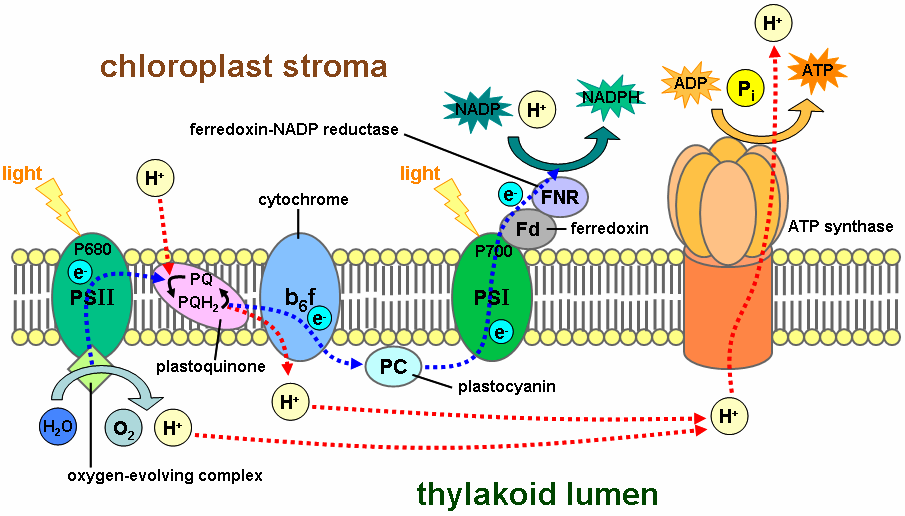PHOTOSYNTHETIC PIGMENTS & PHOTOSYSTEMS
Photosynthetic pigments not only absorb light but also transfer energy to neighbouring molecules. In order to do this efficiently, pigment molecules are bound to particular proteins, which are organized within the thylakoid membrane to produce complexes referred to as photosystems.
Photosystems consists of :
- A large antenna complex (light-harvesting complex) of pigment-proteins that surrounds a central reaction centre
- Reaction centre of a photosystem consists of small number of proteins that bind special chlorophyll a molecules as well as primary electron acceptor
Two types of photosystems in photosynthesis:
- Photosystem I
- Photosystem II
Specialized chlorophyll a in the reaction centre of photosystem I is called P700 because its absorption maximum is at the wavelength of 700 nm
Photosystem II
Reaction centre of photosystem II contains specialized chlorophyll a called P680 which absorbs maximum light at a wavelength of 680 nm
PHOTOSYSTEM II & OXYGENIC PHOTOSYNTHESIS
Remember, oxygenic photosynthesis is the process of stripping 2 water molecules to produce 4 protons, 4 electrons and 1 oxygen molecule. This process only occurs during the development of photosystem II.
Key Events of Photosystem II:
- Absorption of photons by antenna complex results in the energy transfer to reaction centre, resulting in an electron within P680 being excited. The excited state of chlorophyll P680 is referred to as (P680*)
- Once in the excited state, P680* is easily oxidized to P680+ by the primary electron acceptor by which the electron is transferred to the primary electron acceptor and then moves along a chain system we will discuss shortly called electron transport chain.
- Electrons from the splitting of water molecule transfers it to P680+, reducing it to P680. This process is facilitated by an oxygen-evolving complex that is located on luminal side of photosystem II. As a result of the splitting of water, a oxygen molecule is produced.
Light reactions ,as mentioned on Bio 1000- Intro Page, is the first process of photosynthesis. Light reactions are often referred to as Light Dependent Reactions. Ideally, light reactions consists of two major components: protein complexes and mobile electron carriers.
WHAT ARE ELECTRON CARRIERS? Electron carriers are bound to specific proteins that consist of nonprotein cofactors that alternate between being oxidized and reduced as electrons move through the system. In more simple words, electron carriers are proteins that transfer electrons from one complex to another complex. Electron carriers that are part of electron transfer are cytochromes, quinones and iron-sulfur centres
Electron carriers involved in photosynthesis are:
- Plastoquinone
- Plastocyanin
- Ferredoxin
Major protein complexes involved in photosynthesis includes:
- Photosystem II
- Cytochrome complex
- Photosystem I
GENERAL PROCESS OF LIGHT REACTIONS
- The process begins with the absorption of light energy from photosystem II which results in the oxidation of P680. The electron is transferred and used to reduce the primary electron acceptor. P680+ is immediately reduced back to P680 by the splitting of 2 water molecules resulting in electrons being transferred to P680+ by the oxygen-evolving complex.
- From the primary electron acceptor, the electron is transferred to the first electron carrier Plastoquinone (PQ). As the electron is transferred from photosystem II, PQ picks up a proton from the stroma. As PQ transfers the electron to the next protein complex Cytochrome complex, it diffuses its picked up proton into the thylakoid lumen.
- From the cytochrome complex, the electron is transferred to the next electron carrier Plastocyanin
- From here, Plastocyanin moves the electron to photosystem I where the electron is reenergized by light energy and results in the oxidation of P700. The electron is then transferred to the final electron carrier Ferredoxin.
- Ferredoxin transfers the electron to NADP+ reductase complex. NADP+ reductase complex requires two electrons in order to reduce NADP+ to NADPH. P700+ is reduced back to P700 by the electron that comes from Plastocyanin. Once a second electron travels along the chain and reaches NADP+ reductase complex, NADP+ is reduced to NADPH.
- The proton pumping by Plastoquinone creates a concentration gradient of H+ (proton motive force) across the thylakoid membrane. The gradient is used as protons diffuse back into stroma through ATP synthase complex which drives the synthesis of ATP from ADP and Pi.
ATP SYNTHESIS
ATP synthesis is powered by the buildup of a proton gradient. The proton gradient across the thylakoid membrane is obtained by 3 distinct processes:
- Protons are moved from the stroma and into the lumen by electron carrier Plastoquinone as it moves from photosystem II to cytochrome complex
- More protons are added to the lumen through the oxidation of water. Note that the splitting of water molecules occurs on the luminal side of the thylakoid
- The removal of one proton from stroma for each NADPH molecule synthesized. This enhances the gradient across the thylakoid membrane
CYCLIC ELECTRON TRANSPORT
Up to now, we have encountered light reactions of what is called linear electron transport. However, photosystem I can function independently without the requirement of photosystem II and what is referred to as cyclic electron transport.
HOW IT WORKS
In this process:
- Electron flow from photosystem I to Ferredoxin does not involve the electron donation to NADP+ reductase but instead the reduced Ferredoxin donates the electrons back to Plastoquinone.
- This way, Plastoquinone is constantly being oxidized and reduced and keeps protons moving within the thylakoid membrane without using Photosystem II
- Light absorption of photosystem I is used to establish a proton motive force and generate ATP
- No NADPH being produced in cyclic electron transport
- Photosystem II is not being used in cyclic electron transport




No comments:
Post a Comment